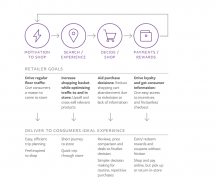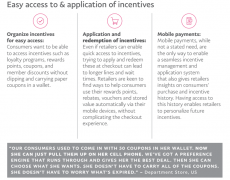What Consumers Are Searching For From Mobile In-Store

New research released by PayPal yesterday (April 20) seems to confirm something we’ve been talking about for a very long time: Consumers want mobile payments solutions that are about more than just paying using their mobile phone.
That conclusion was the result of a PayPal-initiated global survey of retailers around the world to better understand how their customers are using mobile devices in physical stores today — and how they would like to be using those mobile devices in the future.
Those surveyed included merchants in apparel, electronics, mass retail, gas, grocery, quick service restaurants and specialty retail. Participants included senior leaders across technology, finance and marketing.
The survey came away with a process that identified four interconnected stages in retail — and how mobile could be used to optimize all four:
1. Being motivated to shop
2. Searching for what to buy
3. Deciding what to buy
4. Paying – and receiving rewards for doing it.
“The key tenet is that consumers are looking to find ways to use mobile through the entire shopping experience, not just to pay,” Anuj Nayar, PayPal’s Global Head of Product communications, told PYMNTS.
“Customers want to be able to use mobile to search while they’re shopping, make comparison, actually make the payment and then find ways to tie back into post-payment rewards accounts,” Nayar noted. “Consumers want something to take them all the way through.”
Though PayPal is mostly associated with online/mobile payments — and has in fact had something of a rough ride with its initial experiments with adapting PayPal in-store, Nayar notes that this survey, with its focus on the physical retail location, is in line with where consumer demand is headed.
“We’ve been experimenting in-store for four years and what’s happened is it’s not PayPal pushing in-store, it’s consumers pushing us there,” Nayar told PYMNTS.

Moreover, Nayar notes, that change is indicative of a bigger sea-change in both retail and payments. Though the tendency in business is to segment and silo the buying process into its physical, Web-based and app-based (mobile) instantiations, that is not the direction the market is actually evolving. Consumers want experiences that are really seamless and allow easy passage from one form factor to another.
“There are very few technologies that allow consumers to follow the process all the way through,” Nayar said. “PayPal’s vision for this is very different — this [on and offline] is all one market and all payments are moving online, whether you’re shopping online or not.”
But, Nayar emphasized, it’s important to study the individual market pieces, to decide who
 and how to tailor their multichannel product so that it works in the variety of physical channels that exist around the world.
and how to tailor their multichannel product so that it works in the variety of physical channels that exist around the world.
And the white paper did offer a variety of potential fixes to, or “opportunities to fix and delight” consumers by leveraging mobile against common pressure points in the average retail experience.
Those potentially improvable points included building a more seamless omnicommerce experience, making it easier for consumers to conduct real-time research into products (including reviews, pricing data and official ratings) and making the final act of the process, checkout, as frictionless and reward-laden as possible.
That checkout could even, according to some of the merchants PayPal surveyed, be something that is no longer centrally located and a great killer of consumer time.
“It just seems unnatural that you have to go and queue up in the store once you’ve selected all your items, wait for the cashier to get to you and then hand over your credit card and get the transaction done that way. It almost creates another barrier,” one apparel retailer in the APAC region noted in the survey.
The white paper also offered some insight — and focus on mobile payments — with the particular observation that the payment has to be about more than the payment itself to get the job done as a viable and useful tool for retailers to carry in their box of consumer acquisition and retention fixers.
Called out in particular were the needs for security, speed, familiarity, simplicity and technology agnosticism.
Noted the final page of the paper …
PayPal’s retailer survey also stressed the importance of flexibility, and the need to make sure that products are designed with a future-proof orientation in mind.
